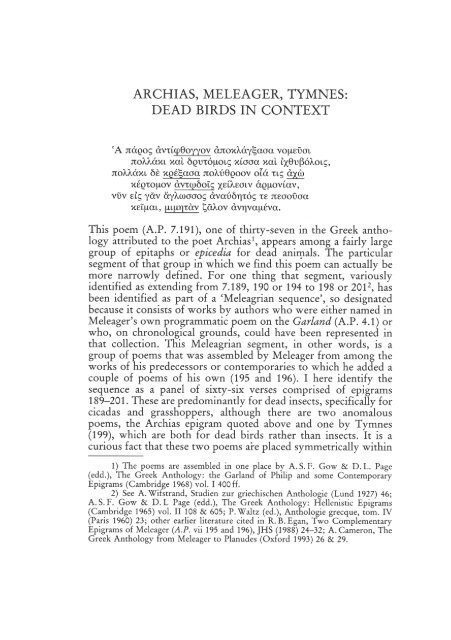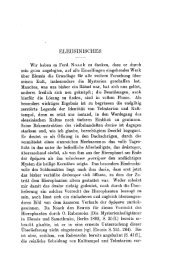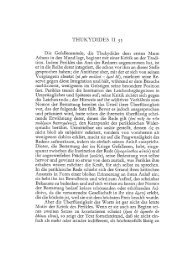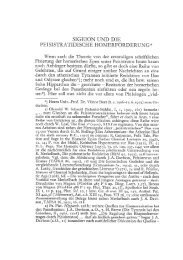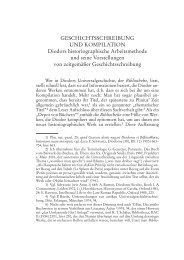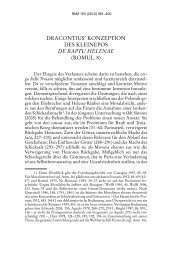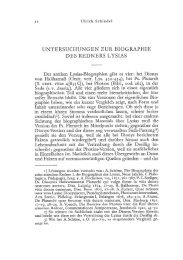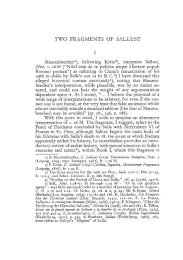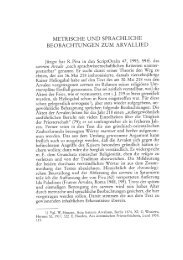ARCHIAS, MELEAGER, TYMNES: DEAD BIRDS IN CONTEXT
ARCHIAS, MELEAGER, TYMNES: DEAD BIRDS IN CONTEXT
ARCHIAS, MELEAGER, TYMNES: DEAD BIRDS IN CONTEXT
You also want an ePaper? Increase the reach of your titles
YUMPU automatically turns print PDFs into web optimized ePapers that Google loves.
<strong>ARCHIAS</strong>, <strong>MELEAGER</strong>, <strong>TYMNES</strong>:<br />
<strong>DEAD</strong> <strong>BIRDS</strong> <strong>IN</strong> <strong>CONTEXT</strong><br />
'A :TtllQO
Archias, Meleager, Tymnes: Dead Birds in Context 25<br />
the panel; 191 beginning eight lines after the beginning of the panel<br />
and 199 ending eight lines before the end of the panel. There is,<br />
moreover, an interval of twelve lines between each of these poems<br />
and the two poems by Meleager. The bird!oems themselves are<br />
not the same length, 191 being six verses an 199 four verses. This<br />
means that in the panel as it stands there are two more verses<br />
preceding the two poems by Meleager than there are following<br />
them. Without the two bird poems, however, there would be a<br />
panel of fifty-six verses of which the sixteen composed by Meleager<br />
are symmetrically bracketed by twenty verses of insect poems<br />
by other authors as in the following schema.<br />
Beginning of Panel<br />
8vv. Insect epitaphs (189, 190)<br />
BIRD EPITAPH (191) 6 vv.<br />
12vv. Insect epitaphs (192,193,194)<br />
<strong>MELEAGER</strong>'S <strong>IN</strong>SECT EPIGRAMS (195,196)<br />
12vv. Insect epitaphs (197, 198)<br />
BIRD EPITAPH (199) 4 vv.<br />
8vv. Insect epitaphs (200, 201)<br />
End of Panel<br />
The presence of two bird epigrams, apparently anomalous as<br />
far as their subject matter is concerned but schematically in balance,<br />
invites some explanation; particularly since by another criterion,<br />
that of shared vocabulary, at least one of them (191) seems to<br />
belong in the context as suggested by the words which I have<br />
underlined in the text of that poem, words which closely match<br />
vocabulary in one or both of Meleager's own poems. Moreover,<br />
despite being anomalous vis-a-vis the insect poems, the two bird<br />
poems have a common feature inasmuch as each of the dead birds<br />
was, in life, an imitator or riyal in song of other birds. A complete<br />
and conclusive explanation for all of this seems out of reach on the<br />
strength of existing evidence which, for one thing, offers no information<br />
on the relative chronology of poems by Meleager and Archias.<br />
I shall, nonetheless, venture a couple of hypotheses.<br />
Where the insect poems are concerned I believe that I have<br />
demonstrated in another article that Meleager not only assembled<br />
earlier epigrams and added two of his own, but that he actually<br />
bound his own poems into context with those of other poets by<br />
adapting and incorporating themes, poetic motifs and vocabulary
26 Rory B. Egan<br />
from his predecessors' works as he composed his own 3 . If it is<br />
correct to see Meleager's two insect poems along with nine other<br />
insect poems comprising a unified poetic panel that comes virtually<br />
intact from an earlier phase in the evolution of the Anthology,<br />
that is from Meleager's Garland, the two anomalous bird poems<br />
might be seen as emplacements by a later anthologist or later anthologists.<br />
On chronological grounds of course it is possible that<br />
199, a poem for a dead thrush by Tymnes, was entered by Meleager,<br />
and the same might even be said for Archias' poem since<br />
Meleager and Archias were probably contemporaries, but there is<br />
no apparent thematic reason for Meleager putting them into context<br />
with insect poems. If Archias' work had been available to<br />
Meleager, as some have thought\ we might have expected the<br />
anthologizing poet to have used Archias' own poem on the cicada,<br />
which appears later in Book 7 (213), in this context. On the other<br />
hand it is difficult to imagine why he would have included either<br />
Archias' poem addressed to a jay or Tymnes' poem addressed to a<br />
thrush here amid the Meleagrian insects.<br />
The fact that the epigram by Archias shares several items of<br />
vocabulary with the poems of Meleager leads me to postulate a<br />
reason for the placement of Archias' jay there. It has to do with the<br />
jay being proverbially, like the parrot, a mimicking bird. Archias<br />
hirnself has been recognized as a mimicking poet, specifically as<br />
one who imitated the poems of Meleager's Garland 5 • But within<br />
the confines of this poetic panel Meleager hirnself offers a truly<br />
virtuoso performance in poetic mimickry. It will be appropriate<br />
now to digress from Archias for a while to review the extent of<br />
Meleager's imitation of other poets' insect epitaphs by demonstrating<br />
his redeployment of the vocabulary of the other eight<br />
poets in their nine poems.<br />
A.P. vii 195<br />
'AXQLS, el-lwv U3t
Archias, Meleager, Tymnes: Dead Birds in Comext<br />
27<br />
aXQL, !tL'tWOU!tEvll
28 Rory B. Egan<br />
the belief that Archias knew and imitated Meleager's work. On the<br />
other hand, it leaves us to explain Tymnes' poem differently.<br />
Chronologically, that poem will have been antecedent to both<br />
Archias and Meleager's anthology. If, however, it were placed by<br />
Meleager in the context in which we have received it, it would not<br />
only have disrupted the insect sequence but would have done so<br />
without the structurally balancing effect of Archias' epigram<br />
which would have been inserted later. An alternative (within the<br />
same general hypothesis) is that some later anthologist, recognizing<br />
Archias' assessment of Meleager as a jay, used a pre-existing<br />
epigram on the dead thrush to counter Archias. Tymnes' epigram<br />
will have done this not only in terms of the spatial or numerical<br />
arrangement of the panel, but thematically as well, for the thrush is<br />
also a 'talking' bird (if it can be identified with the turdus of Pliny,<br />
NH 10.120), though one noted more for its melodious voice than<br />
for its garrulity. In counterpoise with the jay it would perhaps<br />
represent a more complimentary view of Meleager's poetic attributes,<br />
including his mimicry.<br />
A second hypothesis rests on the possibility that both Archias'<br />
epitaph for the jay and Tymnes' epitaph for the thrush were<br />
placed in the panel by Meleager himself as a sort of self-commentary<br />
on what he is doing here. At the same time that he is mimicking<br />
the vocabulary of Archias' poem, - for in this scenario the<br />
relationship of Archias to Meleager is reversed - he is using that<br />
poem as a commentary on his own mimicry of Archias and the<br />
other poets whose insect epitaphs he is capping in 195 and 196. But<br />
just as Meleager places the Archias epigram shortly after the beginning<br />
of the panel and twelve lines before his own imitative work<br />
begins, he places the Tymnes epigram twelve lines after his own<br />
poems as he approaches the end of the panel. It is as if to say "Jay<br />
though I might be in my mimickings, I am a melodious thrush in<br />
the execution of my poems that recapitulate the work of my predecessors<br />
here." Pointedly, the thrush of Tymnes' poem is a favorite<br />
of the Graces (XUQLGLV ~E!-lEA.l"]~EvOV, v. 1) and an emulator of<br />
another song bird, the halcyon 7 (:n:aQo~OLov
Archias, Meleager, Tymnes: Dead Birds in Context 29<br />
poems within the panel of insect poems is not likely to be fortuitous.<br />
This is particularly so when one of those poems is a mimicking,<br />
or mimicked, epitaph for a notorious mimic placed amid a<br />
group of poems that shows an exceptional mimic in action. There<br />
is surely some poetic game being played here. Significant questions<br />
remain, though, as to how many players are involved and the order<br />
in which they have been playing. We can see the pieces deployed<br />
on the gaming board but we can not be sure who has made the<br />
final move. The symmetry of the panel in terms of the situating of<br />
the bird epitaphs and the balanced perspectives on poetic mimicry<br />
that they represent incline me towards the second hypothesis<br />
which would make the compiler-poet Meleager responsible for the<br />
whoIe construction. In that case the relationship between Meleager<br />
and Archias becomes even more intricate, for Meleager, even as he<br />
hirnself mimics Archias' poem, is using that same poem of Archias,<br />
along with the one by Tymnes, as a means of assessing and commenting<br />
on his own mimicry.<br />
If the jay of Archias' epigram represents a poet, then that<br />
epigram anticipates in one important respect Ovid's poem on a<br />
dead parrot (Amores 2.6) and a later one by Statius (Silvae 2.4).<br />
Interpreters of the Ovidian poem have recognized that the parrot<br />
is reaIly an imitative poet, possibly Ovid himselfB. They have also<br />
recognized that in composing his parrot poem Ovid is in various<br />
ways indebted to the HeIlenistic authors of animal epitaphs 9 , and<br />
something similar has been acknowledged for Statius 1o • To my<br />
knowledge, however, no one has entertained the possibility that a<br />
mimetic bird as a figure for a mimetic poet had itself been exploited<br />
by any of Ovid's HeIlenistic forerunners. The possibility<br />
or, as I would say, the likelihood that the birds represent a human<br />
poet, suggests that there might have been an extra dimension or<br />
point of reference, now weIl obscured, for more than one of those<br />
many Greek epitaphs for dead animals, particularly for aIl the<br />
musical and eloquent dead birds and insects of the Greek Anthology<br />
11. In light of that it seems equaIly likely that Ovid was indebt-<br />
8) See K. S. Myers, Ovid's Tecta Ars: Amores 2.6: 'Programmatics and the<br />
Parrot', EMC/CV n.S. 9 (1990) 367-374; B. W. Boyd, The Death of Corinna's<br />
Parrot Reconsidered: Poetry and Ovid's Amores, CJ 80 (1987) 199-207.<br />
9) See Myers (above, n.7) 368. T. G. O. Gollnisch, Quaestiones Elegiacae<br />
(Diss. Breslau 1905) sees traces of A.P. 7.189, 7.190 and 7.194 in Amores 2.6.<br />
10) See H.-J. van Dam, P. Papinius Statius Silvae Book 11: a Commentary<br />
(Leiden 1984) 336 H.<br />
11) Most such poems have been isolated by G. Herrlinger, Totenklage zum<br />
Tiere in der antiken Dichtung (Stuttgart 1930).
30 Rory B. Egan<br />
ed to Hellenistic poets, not only in the use of the sepulchral animal<br />
epigram but also for the conceit which represents a poet through a<br />
parrotting dead bird.<br />
Winnipeg, Manitoba<br />
Rory B. Egan


